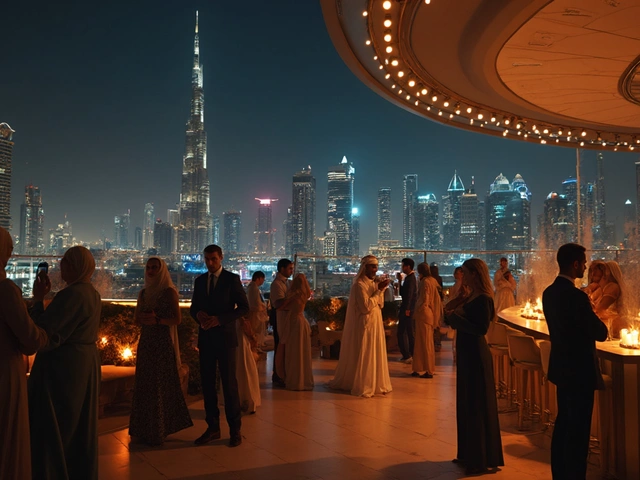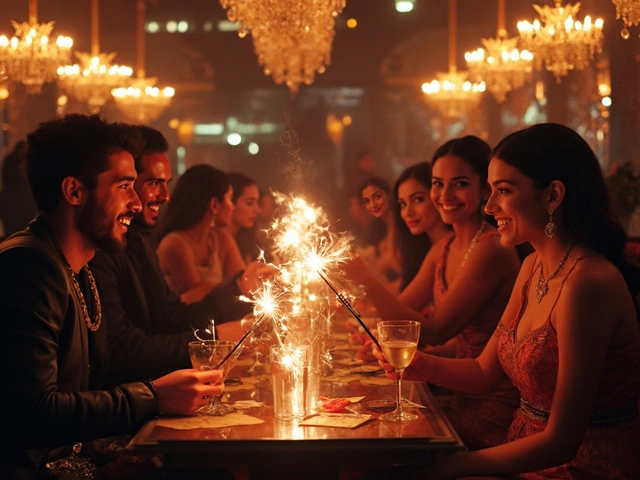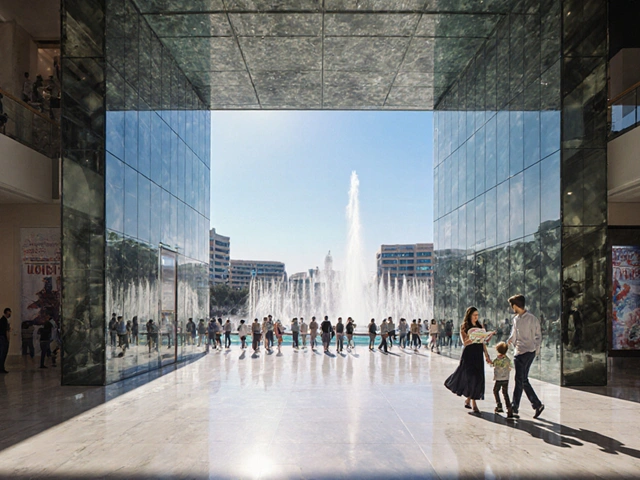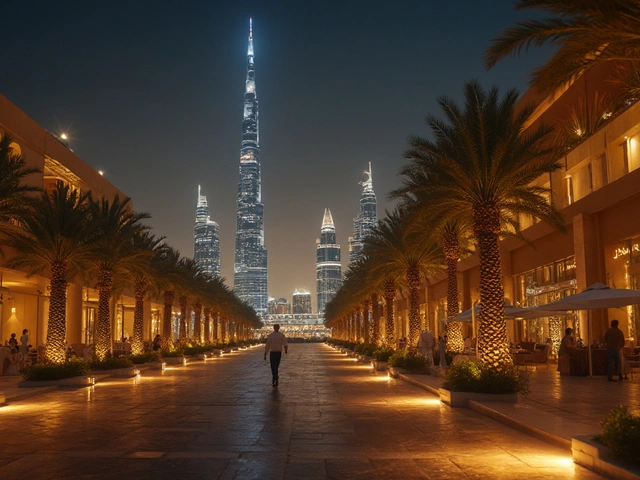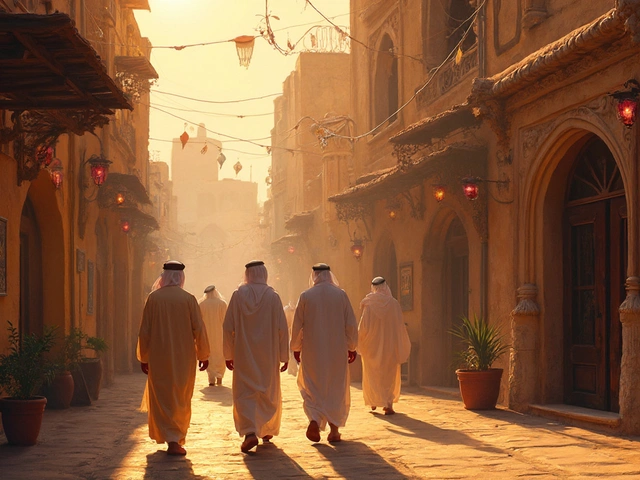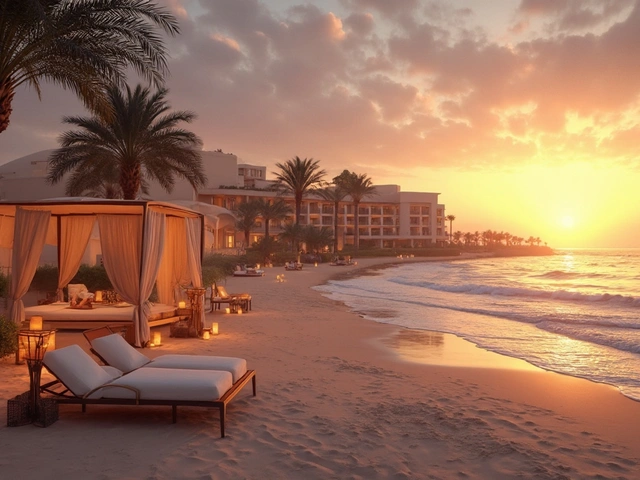Dubai’s skyline isn’t just famous for its height—it’s like a living, breathing museum of bold architecture and wild ambition. Ask anyone who’s lived here for more than a month, and they’ll tell you the same thing: iconic buildings in Dubai don’t just decorate the city, they create its pulse. Walk through Downtown Dubai and it’s almost impossible not to feel the buzz when you’re near the Burj Khalifa or the twisting Cayan Tower. These structures aren’t background noise—they set the mood for daily life, business deals at Dubai International Financial Centre, and even how residents show off their home turf to visiting friends and family.
In Dubai, these buildings do more than just catch your eye. They act as meeting points, inspiration for social media snaps, and even places to learn about the UAE’s traditions (Ever visited Jumeirah Mosque or peeked inside Al Fahidi Historical Neighbourhood?). Dubai’s mix of glass, steel, and old stone tells a story. It’s not just a tourist brag, either. For expats, locals, and even the weekend crowd, knowing a bit about these iconic sites makes city living richer. Whether you’re trying to impress a client at Atmosphere Lounge or planning a sunset walk around Dubai Marina, these buildings shape everything from your Instagram feed to your personal sense of style.
- Why Iconic Buildings Matter in Dubai
- Landmarks That Changed the City Skyline
- The Blend of Culture and Modernity
- How to Experience Dubai’s Architecture Up Close
- What the Future Holds for Dubai’s Skyline
Why Iconic Buildings Matter in Dubai
Drive anywhere in Dubai, and the buildings do all the talking. The city gets attention worldwide because of its jaw-dropping skyline, but there’s more to it than bragging rights. In Dubai, buildings like Burj Khalifa and the Museum of the Future are not just for show—they shape how people work, socialize, and see their city. These places pull in tourists, host major events, and even give locals and residents daily landmarks for getting around.
Here’s the deal: when a city invests in wild designs and world records, it’s also investing in its economy. Just look at visitor stats. The Burj Khalifa alone draws about two million tourists a year, and the Dubai Mall, connected right next door, brings in over 80 million visitors annually. This isn't just impressive—it's fuel for hotels, restaurants, and malls around Downtown. Every international event, from Expo City Dubai expos to business conferences at Madinat Jumeirah, leans on these buildings for both the wow factor and practical space.
The real kicker is how these buildings create an identity. For Emiratis, having an instantly recognizable skyline is a way to show modern progress while staying connected to history. Architectural touches inspired by local wind towers, mashrabiya screens, and sand-hued colors nod to heritage even in the newest towers. So, these buildings turn into teaching tools, not just landmarks.
Need some numbers to see the scope? Check this out:
| Building | Opened | Height (meters) | Annual Visitors |
|---|---|---|---|
| Burj Khalifa | 2010 | 828 | 2,000,000+ |
| Dubai Frame | 2018 | 150 | 1,000,000+ |
| Burj Al Arab | 1999 | 321 | Hotel Guests/Visitors 300,000+ |
So if you’re living or working here, these Dubai architecture icons don’t just set the background—they push the city forward. They give everyone, from taxi drivers to business execs, something to talk about and even add to personal pride. Next time you point them out to a visitor, remember: these buildings are why Dubai feels like nowhere else.
Landmarks That Changed the City Skyline
If you think of Dubai, it’s probably images of the Burj Khalifa or Burj Al Arab that jump into your head first. These landmarks aren’t just decorative—they basically put the city on the world map. Take the Burj Khalifa. It’s not just the tallest building on Earth at 828 meters, it’s become a symbol of what Dubai can accomplish when it sets big goals. Since opening in 2010, it’s attracted millions of visitors, hosted everything from New Year fireworks to daily fountain shows, and pushed property values in Downtown Dubai through the roof.
Burj Al Arab, with its sail-shaped silhouette, is a luxury icon. Since 1999, this hotel has redefined what five-star service means in the region. It made the idea of ‘seven-star’ hotels a thing, even though there’s no official ranking above five stars. The hotel sits on an artificial island and the helipad alone has hosted tennis matches and car commercials—yeah, people have landed helicopters there just for brunch.
Don’t overlook the Museum of the Future. Its shiny torus shape stands out on Sheikh Zayed Road, reflecting both tradition (those calligraphic quotes on the outside?) and a future-minded attitude. Built with advanced 3D-printing techniques, it’s one of the world’s most complex buildings and opened in 2022. It’s packed with interactive exhibits on everything from climate change to robotics, making it popular for families, students, and tech heads.
The Dubai Frame is another crowd-pleaser, especially for locals who love a good viewpoint. Sitting at Zabeel Park, it frames Old Dubai and New Dubai for a unique photo-op. There’s a glass walkway up top—perfect for folks who like a little adrenaline with their views.
For those who want a bit of history mixed with modern design, you can’t ignore Emirates Towers and Cayan Tower. Emirates Towers has long been home to major banks and top law firms since 2000, shaping the whole business vibe of Sheikh Zayed Road. Cayan Tower, famous for its 90-degree spiral design, adds a flashy twist (literally) to the Dubai Marina skyline.
Check out this short table to get a sense of the numbers behind these buildings:
| Landmark | Year Completed | Height (meters) | Main Function |
|---|---|---|---|
| Burj Khalifa | 2010 | 828 | Mixed-use (residential, offices, hotel) |
| Burj Al Arab | 1999 | 321 | Luxury hotel |
| Museum of the Future | 2022 | 77 | Museum/Exhibition |
| Dubai Frame | 2018 | 150 | Observation deck/Tourism |
| Cayan Tower | 2013 | 306 | Residential |
When you walk or drive through Dubai, each of these buildings stands out for a reason. Whether you’re new to the city or a long-time resident, spotting these landmarks never really gets old. They don’t just fill out the skyline—they broadcast Dubai’s growth and ambition to anyone paying attention.
The Blend of Culture and Modernity
Dubai pulls off something most cities struggle to get right: mixing old traditions with new ideas right in its architecture. Take a stroll around the Al Fahidi Historical Neighbourhood, and the vibe is pure heritage—wind towers, narrow lanes, and those classic sandy hues. Just a quick drive away, you hit the Dubai architecture icons like the Burj Al Arab, shaped like a sail, or the Museum of the Future, which looks like something out of a sci-fi movie with its oval shape and Arabic calligraphy punched straight into the metal.
What’s wild is how developers don’t just forget about the UAE’s roots in all this growth. For example, look at the Jumeirah Mosque, which welcomes non-Muslims for guided tours—a real chance to see how religion, hospitality, and daily life all tie in here. The Etihad Museum lets you check out the country’s founding story through interactive exhibits, and the whole building is designed to look like a manuscript, connecting old stories to fresh experiences.
Modern towers in Business Bay and DIFC often sneak in Arabic patterns, courtyards, or mashrabiya-style screens to respect privacy—the stuff that’s always mattered in Emirati homes. Even souk-inspired shopping at Madinat Jumeirah or the giant palm trees lining Dubai Mall promenade remind you Dubai isn’t trying to copy-paste Western ideas. It’s putting its own spin on things.
If you’re living, working, or just visiting Dubai, look out for:
- Traditional patterns and script in places you’d least expect—like high-end hotels and the metro stations.
- Events like Dubai Design Week, where local architects show off how they mix culture with tech.
- Public art installations that use Arabic geometry or materials you’d find in the desert.
The cool part is you don’t have to be an expert to notice how culture and modernity mix in every view. Just be curious—keep an eye out for details the next time you’re staring up at a skyscraper or wandering through a bustling souk. You’ll see how Dubai tells its story with every new building.
How to Experience Dubai’s Architecture Up Close
If you really want to appreciate Dubai’s design boom, you’ve got to get off the couch and go see these places for yourself. Let’s talk about actual ways to experience Dubai architecture firsthand, whether you’re here for a weekend or you call the city home.
First, nothing beats visiting the top of Burj Khalifa. Book tickets ahead of time for the At the Top experience — it’s always busy, especially on weekends, but worth it for the citywide view. Locals often skip this thinking it’s too touristy, but once you’re up there you’ll understand why it’s on every must-see list.
Want something different? Head over to the Museum of the Future. The building itself is already an icon, with that crazy torus shape and Arabic calligraphy. Inside, there are exhibits on everything from sustainability to space travel. Buy your tickets online, since they usually sell out fast.
If modern glass towers aren’t your thing, wander through the Al Fahidi Historical Neighbourhood. The lanes are tight and shady, the wind towers are classic Emirati design, and there’s loads of art in the coffee shops and galleries. Stop by the Dubai Museum in the old Al Fahidi Fort if you want a crash course on how this city sprang up from the desert.
Guided architecture tours make things super easy if you want an expert walk-through. Check offerings from companies like Dubai Architecture Tours or Context Travel. They’ll break down everything from the style of the Burj Al Arab to how city planners balance local traditions with futuristic buildings. Some tours even include entry to private rooftops or areas off-limits to average visitors.
Want to mix things up? Try seeing the city from the water. Book a boat ride along Dubai Creek or take a sunset cruise around the Palm Jumeirah — you’ll get angles and skyline shots that you just can’t find from a street-level stroll. Finally, keep an eye out for annual events like the Dubai Design Week or Open House Dubai in November, where you can peek into buildings that aren’t usually open to the public.
What the Future Holds for Dubai’s Skyline
If you think Dubai’s done building, think again. The city’s not slowing down anytime soon when it comes to jaw-dropping towers and wild new ideas in architecture. In fact, developers and architects are already working on projects that aim to keep Dubai ahead in the global race for the world’s most impressive skyline.
One of the biggest things on the horizon is the Dubai Creek Tower. Planned for Dubai Creek Harbour, it’s supposed to shoot past even the Burj Khalifa, though construction has been put on pause since 2020. If it resumes and hits its target height—over 1,300 meters—it’ll set new records. Right next door, Dubai Urban Tech District aims to make sustainability cool, with dedicated spaces for green tech businesses and research. Ever heard of District 2020? It’s the legacy project of Expo 2020, transforming the expo grounds into a mixed-use city for startups and innovation.
Here’s some data on Dubai’s future skyline projects and their expected impact:
| Project | Expected Height (m) | Intended Use | Status |
|---|---|---|---|
| Dubai Creek Tower | 1,300+ | Observation, mixed-use | On hold |
| Urban Tech District | 40+ | Offices, labs | Under development |
| One Za'abeel | 330 | Residences, offices, hotel | Nearing completion |
| Wasl Tower | 302 | Hotel, apartments | Delayed |
What’s also cool is Dubai’s push for eco-friendly architecture. Upcoming buildings are loaded with smart features like solar panels, energy-efficient cooling, and even vertical gardens. That means the city you see in 2030 is going to use less energy and save water, which matters when you’re living in the desert.
If you’re thinking about moving here, investing, or just plain curious, keep an eye on districts like Jumeirah Lakes Towers and Business Bay. Both are getting new mixed-use skyscrapers aimed at tech workers and young families. Plus, Dubai’s government is pushing for more public spaces and easy-to-walk neighborhoods, not just flashy towers.
Bottom line: Dubai isn’t just building higher. It’s trying to build smarter, greener, and with a vision for the next generation. That’s why the Dubai architecture scene keeps turning heads—and why it’s a big deal for anyone living in or visiting the city.

